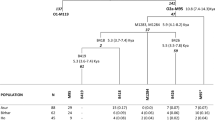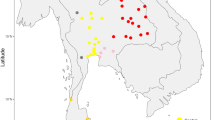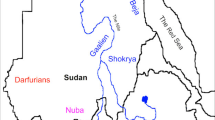Abstract
The northern region of the Indian subcontinent is a vast landscape interlaced by diverse ecologies, for example, the Gangetic Plain and the Himalayas. A great number of ethnic groups are found there, displaying a multitude of languages and cultures. The Tharu is one of the largest and most linguistically diverse of such groups, scattered across the Tarai region of Nepal and bordering Indian states. Their origins are uncertain. Hypotheses have been advanced postulating shared ancestry with Austroasiatic, or Tibeto-Burman-speaking populations as well as aboriginal roots in the Tarai. Several Tharu groups speak a variety of Indo-Aryan languages, but have traditionally been described by ethnographers as representing East Asian phenotype. Their ancestry and intra-population diversity has previously been tested only for haploid (mitochondrial DNA and Y-chromosome) markers in a small portion of the population. This study presents the first systematic genetic survey of the Tharu from both Nepal and two Indian states of Uttarakhand and Uttar Pradesh, using genome-wide SNPs and haploid markers. We show that the Tharu have dual genetic ancestry as up to one-half of their gene pool is of East Asian origin. Within the South Asian proportion of the Tharu genetic ancestry, we see vestiges of their common origin in the north of the South Asian Subcontinent manifested by mitochondrial DNA haplogroup M43.
Similar content being viewed by others
Log in or create a free account to read this content
Gain free access to this article, as well as selected content from this journal and more on nature.com
or
References
Guneratne A : Many Tongues, One People: The Making of Tharu Identity in Nepal. Ithaca, NY, USA: Cornell University Press, 2002.
Buchanan-Hamilton F : History, Antiquities, Topography and Statistics of Eastern India Martin M (ed). Wm. H. Allen & Co.: London, 1838; 2: 705–706.
Crooke W : The Tribes and Castes of the North-Western Provinces and Oudh. Office of the Superintendent of Government Printing: India, 1896.
Grierson GA (ed.):: Linguistic Survey of India (Vol V. Indo-Aryan Family, Eastern Group, Part II: Specimens of the Bihari and Oriya Languages), Calcutta, India: Superintendent of Government Printing, 1903.
Grierson GA : Linguistic Survey of India: Including Khassi and Tai. Mo-Khme and Siamese-Chinese Families. Office of the Superintendent of Government Printing: India, 1904.
van Driem G (ed.):: Languages of the Himalayas, Leiden 2001.
Passarino G, Semino O, Modiano G, Santachiara-Benerecetti AS : COII/tRNA(Lys) intergenic 9-bp deletion and other mtDNA markers clearly reveal that the Tharus (southern Nepal) have Oriental affinities. Am J Hum Genet 1993; 53: 609–618.
Passarino G, Semino O, Pepe G et al: MtDNA polymorphisms among Tharus of eastern Terai (Nepal). Gene Geogr 1992; 6: 139–147.
Koirala S, Shah S, Baral P A comparative anthropometric study of mongoloid and Tharu ethnic races in Eastern Nepal.: WebmedCentral Anatomy 2012; 3: WMC003512.
Chhetri RB : The plight of the Tharu Kamaiyas in Nepal: a review of the social, economic and political facets. Occas Papers Sociol Anthropol 2005; 9: 22–46.
Modiano G, Morpurgo G, Terrenato L et al: Protection against malaria morbidity: near-fixation of the α-thalassemia gene in a Nepalese population. Am J Hum Genet 1991; 48: 390–397.
Terrenato L, Shrestha S, Dixit K et al: Decreased malaria morbidity in the Tharu people compared to sympatric populations in Nepal. Ann Trop Med Parasitol 1988; 82: 1–11.
Skar H : Nepal, indigenous issues and civil rights: the Plight of the Rana Tharu; in Barnes R, Gray A, Kingsbury B (eds):: Indigenous Peoples of Asia, Ann Arbor, MI, USA: Association for Asian Studies, 1993, pp 173–194.
Fornarino S, Pala M, Battaglia V et al: Mitochondrial and Y-chromosome diversity of the Tharus (Nepal): a reservoir of genetic variation. BMC Evol Biol 2009; 9: 154.
Krauskopff G : An ‘Indigenous Minority’ in a border area: Tharu Ethnic Associations, NGOs, and the Nepalese State; in Gellner D (ed.):: Resistance and The 79 State: Nepalese Experiences, NewDelhi: Social Science Press 2007, pp 199–243.
Jeffery R, Jeffery P : Population, Gender and Politics: Demographic Change in Rural North India. Cambridge University Press, 1997.
Ghurye GS : Caste and Race in India. Popular Prakashan, 1969.
Reich D, Thangaraj K, Patterson N, Price AL, Singh L : Reconstructing Indian population history. Nature 2009; 461: 489–494.
HUGO Pan-Asian SNP Consortium, Abdulla MA, Ahmed I et al: Mapping human genetic diversity in Asia. Science 2009; 326: 1541–1545.
Kamberov YG, Wang S, Tan J et al: Modeling recent human evolution in mice by expression of a selected EDAR variant. Cell 2013; 152: 691–702.
Chaubey G, Metspalu M, Choi Y et al: Population genetic structure in Indian Austroasiatic speakers: the role of landscape barriers and sex-specific admixture. Mol Biol Evol 2011; 28: 1013–1024.
Behar DM, van Oven M, Rosset S et al: A ‘copernican’ reassessment of the human mitochondrial DNA tree from its root. Am J Hum Genet 2012; 90: 675–684.
Soares P, Ermini L, Thomson N et al: Correcting for purifying selection: an improved human mitochondrial molecular clock. Am J Hum Genet 2009; 84: 740–759.
Zhivotovsky LA, Underhill PA, Cinnioglu C et al: The effective mutation rate at Y chromosome short tandem repeats, with application to human population-divergence time. Am J Hum Genet 2004; 74: 50–61.
Sengupta S, Zhivotovsky LA, King R et al: Polarity and temporality of high-resolution y-chromosome distributions in India identify both indigenous and exogenous expansions and reveal minor genetic influence of Central Asian pastoralists. Am J Hum Genet 2006; 78: 202–221.
Purcell S, Neale B, Todd-Brown K et al: PLINK: a tool set for whole-genome association and population-based linkage analyses. Am J Hum Genet 2007; 81: 559–575.
Patterson N, Price AL, Reich D : Population structure and eigenanalysis. PLoS Genet 2006; 2: e190.
Alexander DH, Novembre J, Lange K : Fast model-based estimation of ancestry in unrelated individuals. Genome Res 2009; 19: 1655–1664.
Cockerham CC, Weir BS : Covariances of relatives stemming from a population undergoing mixed self and random mating. Biometrics 1984; 40: 157–164.
Bhatia G, Patterson N, Sankararaman S, Price AL : Estimating and interpreting FST: the impact of rare variants. Genome Res 2013; 23: 1514–1521.
Lawson DJ, Hellenthal G, Myers S, Falush D : Inference of population structure using dense haplotype data. PLoS Genet 2012; 8: e1002453.
Browning SR, Browning BL : Rapid and accurate haplotype phasing and missing-data inference for whole-genome association studies by use of localized haplotype clustering. Am J Hum Genet 2007; 81: 1084–1097.
Metspalu M, Romero IG, Yunusbayev B et al: Shared and unique components of human population structure and genome-wide signals of positive selection in South Asia. Am J Hum Genet 2011; 89: 731–744.
Gayden T, Cadenas AM, Regueiro M et al: The Himalayas as a directional barrier to gene flow. Am J Hum Genet 2007; 80: 884–894.
Wang HW, Li YC, Sun F et al: Revisiting the role of the Himalayas in peopling Nepal: insights from mitochondrial genomes. J Hum Genet 2012; 57: 228–234.
Petraglia M, Clarkson C, Boivin N et al: Population increase and environmental deterioration correspond with microlithic innovations in South Asia ca. 35,000 years ago. Proc Natl Acad Sci USA 2009; 106: 12261–12266.
He JD, Peng MS, Quang HH et al: Patrilineal perspective on the Austronesian diffusion in Mainland Southeast Asia. PLoS ONE 2012; 7: e36437.
Thangaraj K, Chaubey G, Kivisild T et al: Maternal footprints of Southeast Asians in North India. Hum Hered 2008; 66: 1–9.
van Driem G : The ethnolinguistic identity of the domesticators of Asian rice. Comptes Rendus Palevol 2012; 11: 117–132.
Acknowledgements
We thank the Tharu community for the kind participation to this study. Chandana Basu Mallick for useful discussion and proof read. This study was supported by the European Union European Regional Development Fund through the Centre of Excellence in Genomics to Estonian Biocentre and University of Tartu to RV, MM and GC, by Tartu University grant (PBGMR06901) to TK and other supporting funding sources were ERC Starting Investigator grant (FP7 – 261213) to TK; Estonian Institutional Research grant IUT24-1 to RV; European Commission grant (ECOGENE 205419) to RV; Estonian Science Foundation grant (8973) to MM and UK-India Education Research Initiative (RG47772) grant to FC, MML, KT and TK. KT was supported by the Council of Scientific and Industrial Research, Government of India (GENESIS: BSC0121) and (BSC 0208). LS was supported by Bhatnagar (CSIR) and JC Bose (DST) Fellowships, Government of India. AKP and RT were supported by the European Social Funds Doctoral Studies and Internationalisation Programme DoRa. The funders had no role in the study design, data collection and analysis, decision to publish, or preparation of the manuscript. This work was carried out in part in the High Performance Computing Center of University of Tartu.
Author information
Authors and Affiliations
Corresponding authors
Additional information
Supplementary Information accompanies this paper on European Journal of Human Genetics website
Rights and permissions
About this article
Cite this article
Chaubey, G., Singh, M., Crivellaro, F. et al. Unravelling the distinct strains of Tharu ancestry. Eur J Hum Genet 22, 1404–1412 (2014). https://doi.org/10.1038/ejhg.2014.36
Received:
Revised:
Accepted:
Published:
Issue date:
DOI: https://doi.org/10.1038/ejhg.2014.36
This article is cited by
-
G6PD deficiency in malaria endemic areas of Nepal
Malaria Journal (2020)
-
Reconstructing the population history of the largest tribe of India: the Dravidian speaking Gond
European Journal of Human Genetics (2017)
-
The paternal ancestry of Uttarakhand does not imitate the classical caste system of India
Journal of Human Genetics (2016)



